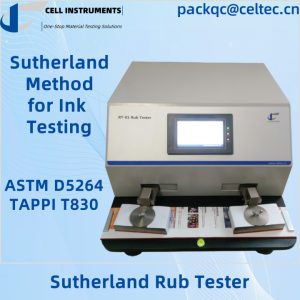Hướng dẫn thử nghiệm độ bền mài mòn in ấn bằng phương pháp Sutherland Rub Test
In the world of printed packaging, labels, and commercial print media, abrasion resistance is crucial for maintaining product quality and branding. The thử nghiệm cọ xát sutherland, standardized under Tiêu chuẩn ASTMD5264, offers a reliable method to evaluate the durability of printed surfaces against rubbing or scuffing during transport, storage, or handling. This article explains the fundamentals of the test, highlights the recommended quy trình thử nghiệm cọ xát sutherland, and introduces a reliable solution—Cell Instruments’ RT-01 Ink Abrasion Resistance Tester—to help professionals carry out accurate and repeatable assessments.
Understanding the Importance of the Sutherland Rub Test
Printed materials often encounter surface abrasion during the product lifecycle. Whether it’s shipping, shelf display, or customer handling, friction can degrade ink, coatings, or printed information. The thử nghiệm cọ xát sutherland offers a standardized method to simulate these conditions and evaluate:
- Các abrasion resistance of inks, coatings, or laminates
- Comparative wear performance between printed samples
- The effect of environmental factors like temperature or humidity on durability
- The scuff resistance of packaging labels, folding cartons, and other substrates
Các Tiêu chuẩn ASTMD5264 standard outlines precise steps and apparatus settings to ensure reproducibility and comparability between different laboratories or production lines.
Sutherland Rub Test Procedure According to ASTM D5264
The correct implementation of the quy trình thử nghiệm cọ xát sutherland is essential for obtaining valid, actionable data. Here’s a breakdown of the process:
Equipment and Materials
- Máy kiểm tra độ cọ xát Sutherland with selectable weights (2-lb or 4-lb)
- Rubber pads (76 mm × 152 mm) with Shore A hardness of 15 ± 5
- Standard receptor sheets, sized 51 mm × 178 mm or 51 mm × 102 mm
- Test specimens (preferably 76 mm × 152 mm)
- Pressure-sensitive tape (if required)
- Camel’s hair anti-static brush
- Conditioned environment: 23 ± 1 °C and 50 ± 2% RH (as per ASTM D4332)
Step-by-Step Test Execution
- Conditioning: Ensure all materials are conditioned for at least 24 hours in a controlled environment.
- Sự chuẩn bị:
- Attach the test specimen to the rubber pad on the tester base.
- Fix the receptor to the receptor block using clamps or tape.
- Weight Selection:
- Use the 4-lb block for high-friction applications.
- Use the 2-lb block for general printed material.
- Stroke Settings: Preselect the number of double rub cycles (a stroke is a complete back-and-forth motion).
- Kiểm tra:
- Place the block into the holder.
- Activate the machine to begin the rubbing cycles.
- The tester will automatically stop after completing the preset number of strokes.
- Evaluation:
- Visually inspect the test specimen for degradation (fading, ink loss).
- Analyze the receptor for ink transfer.
- Compare with reference samples to quantify abrasion resistance.
Best Practices for Reliable Rub Test Results
To ensure repeatability and accuracy:
- Avoid over-testing: excessive strokes generate heat and skew results.
- Replace rubber pads periodically; worn pads compromise uniformity.
- Maintain a clean surface—use anti-static brushes before every run.
- Keep sample orientation consistent, especially regarding machine direction.
- Prevent sample contamination with gloves or tweezers.
Applications and Benefits for Packaging and Printing
Các thử nghiệm cọ xát sutherland is widely applicable across industries:
- Dược phẩm: ensuring legibility of printed dosage or warning labels
- Food and beverage: maintaining brand appearance on cartons, pouches
- Mỹ phẩm: validating surface wear of printed folding boxes or sleeves
- Industrial labels: ensuring durability under moisture or friction exposure
It also supports R&D teams in ink formulation, substrate selection, Và quality benchmarking for competitive packaging performance.
Why Choose the RT-01 Ink Abrasion Resistance Tester by Cell Instruments?
Các RT-01 từ Công ty TNHH Cell Instruments is specifically designed for precision rub resistance testing compliant with ASTM D5264. Key features include:
- Adjustable test stroke settings for flexibility across product types
- Support for both 2-lb and 4-lb weight blocks, ideal for various conditions
- Stable motor-driven mechanism for uniform back-and-forth motion
- Easy sample mounting system to reduce handling errors
- Sturdy build quality, ensuring long-term test consistency
Professionals in packaging, quality control, and product development choose RT-01 for its performance, ease of use, and compatibility with global standards.
Phần kết luận
Các thử nghiệm cọ xát sutherland is indispensable for ensuring the longevity and quality of printed packaging and labeling. Following the correct quy trình thử nghiệm cọ xát sutherland, as defined by Tiêu chuẩn ASTMD5264, empowers quality assurance professionals to detect potential scuffing problems early and mitigate risks. With the Máy kiểm tra độ mài mòn mực RT-01 từ Dụng cụ tế bào, laboratories and production facilities can execute standardized, repeatable tests that drive confident decisions in material development and quality assurance.

